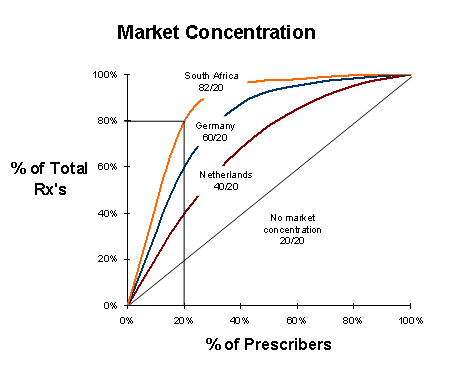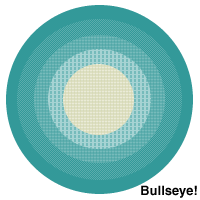 |
|||||||||||||||||||||||||||||||||||||||||||||||||||
| May 2003 | |||||||||||||||||||||||||||||||||||||||||||||||||||
Anyone familiar with the game of darts knows how difficult it is to hit the bull's-eye—even from a short distance. Now imagine trying to hit the bull's-eye while blindfolded. A difficult task becomes nearly impossible. In the US, credible vendors provide sales reps with excellent physician-level prescribing data, essentially helping them aim for the dartboard with eyes wide open. Those in many international markets typically aren't as fortunate, as regulatory or market constraints limit the availability of physician prescribing data. As in the US, international reps still have to hit the bull's-eye, but lack the advantage of seeing where they're aiming. "I don't know the key to success,
but the key to failure is trying to please everybody." Bill Cosby was never a sales manager, but his quote illustrates one of the keys of sales success — forget about trying to get them all; focus efforts on a meaningful target group of customers. Target customers represent the bull's-eye, and may be selected by sales reps, sales managers or marketing departments. But regardless of who chooses the targets, sales success depends heavily on choosing the most profitable customers and then focusing sales effort on that target list. For most companies, better customer targeting will significantly improve short-term sales.
Why does effective targeting improve sales? Markets are concentrated. Most people are familiar with the old adage that 20% of customers account for 80% of sales. In reality, pharmaceutical market concentration varies considerably based on the therapeutic category and type of medical system (Figure 1). Even in the least concentrated markets, calling on the high-value physicians rather than average-value physicians can make a substantial difference in sales performance. Figure 2 illustrates the average number of prescriptions per week per physician for a hypothetical product class in markets of varying concentration. Even in the least concentrated market (market A) - the top 20% of doctors write only 40% of total
prescriptions - a doctor in the top quintile writes 30 prescriptions per week compared to only 4 prescriptions for the typical doctor in the bottom quintile and 15 prescriptions for the "average" doctor. Consider two firms launching new products in the same therapeutic class. Each firm calls on 1,000 physicians. Firm A selects 1,000 average-value customers. Firm B selects 1,000 high-value customers. In this case, let's assume that both firms have equally effective sales reps, and that both firms receive 15% of the total prescriptions written by the physicians they visit. If targeting is a critical sales success factor, how can sales forces identify those top doctors? Reps need to be able to see the dartboard if they want to hit the bull's-eye. Basic targeting begins by selecting doctors with the highest therapeutic class sales for the first line product. Focusing on these high-value physicians often means making tough decisions to drop low-value physicians from the target list even though they:
Sales forces outside the US generally don't have universal physician
prescribing data—many markets have no physician-level data.
How do these markets effectively target the most valuable customers,
when they're essentially having to draw the dartboard? In these markets,
sales organizations must implement a disciplined doctor profiling process
in order to estimate each doctor's total therapeutic class potential
for each key product. It's important
Third party sample prescribing data can substantially improve the profiling process. IMS and Close-Up, for example, collect sample prescribing data in European, Asian and Latin American markets. These samples typically range from 10% to 50% of relevant physician populations and can provide sales managers an important supplement to the profiling process. As one example, sample data may provide appropriate criteria for populating a target list. Let's imagine that a sales force has a goal of 30% reach on primary care physicians for an antibiotic. A sample of physicians in the market indicates that the top 30% of doctors each write at least 28 antibiotic prescriptions per week. Then, each rep's target list should include doctors prescribing at least 28 antibiotics per week and should exclude physicians writing less than 28 antibiotics per week. Similar criteria can also be derived through a disciplined profiling process, but some firms may view third-party data as more credible and less uncertain than rep-reported profile estimates. Regardless of whether they use sample data or not, firms that implement basic profiling and targeting processes can increase market coverage by as much as 50-100% with immediate sales gains of 5-10% and much larger long-term sales gains (see Figure 3). Once the location of the dartboard is known, firms can fill in concentric circles of declining size until they've identified the bull's-eye. Firms with more experienced sales forces can supplement quantitative targeting methods with qualitative profiling. For instance, a firm preparing to launch a new hypertensive (HT) product might profile doctors on their willingness to prescribe new products. The targeting process might begin by identifying doctors with the highest HT class potential. Then, the target list is revised. High potential doctors who aren't likely to prescribe new products are replaced by moderate potential doctors with a tendency to adopt new products quickly. This more complex targeting process requires outstanding sales training and coaching as well as effective coordination between marketing and sales functions. A more sophisticated targeting process adds additional qualitative targeting considerations. This process is typically used in markets like the US where robust physician-level data is available, but it can be successfully implemented in international markets with disciplined sales forces. Firms may adopt multiple criteria for targeting customers. In the case of our HT product, reps might also target physicians who are known to spread their prescriptions across many HT products or to heavily prescribe a distinctly inferior competitive product. International managers can utilize sample data to implement this process. Firms using a multiple-criteria targeting process often limit sales rep influence over the target list. This process requires excellent communication between sales and marketing as well as a high level of field force ability and discipline. Conclusion By effectively drawing the dartboard and then limiting sales effort to customers in the bull's-eye, pharmaceutical firms can dramatically increase sales effectiveness without additional investment in sales force hiring or marketing spend. Our next newsletter will discuss 1) how to use internal call tracking and vendor prescribing data to measure the quality of a target list, and 2) how to systematically improve "targeting effectiveness" and sales results.
Questions If you have questions or would like to discuss the contents of this article, please send us an e-mail and a senior consultant will respond to you. Other Newsletter Articles This Quarter A Coach's Guide to Field Days -- Tiger Woods may be the greatest golfer of all time, but even Tiger attributes much of his success to having a great coach. Butch Harmon has coached Tiger for more than a decade and has helped him to consistently improve his performance. In many sales organizations, District Sales Managers (DSMs) spend two to four days a week in the field "coaching" their sales teams. This article describes how sales managers who implement a coaching process similar to Butch and Tiger's can significantly improve the performance of their reps. Measuring Sales Force Effectiveness -- This month we conclude our four-part series on Sales Force Effectiveness (SFE) with an article on measuring effectiveness and monitoring performance. Prior articles in the series described a process to diagnose and identify improvement opportunities, prioritize opportunities and develop solutions, and implement change. Measuring and monitoring performance is a critical component of this process that helps sustain effectiveness gains. Prior Newsletters To view prior newsletters, please visit our newsletter index at http://www.rmcionline.com/html/news/ Subscribe/Unsubscribe Please click here to unsubscribe from the RMCI newsletter. Copyright Notice Copyright 2003, RM Consulting International. All rights reserved. Every viewer may copy, reprint or forward all or part of this newsletter to friends, colleagues or customers, so long as any use is not for resale or profit and the following copyright notice is included intact: "Copyright 2003, RMCI. All rights reserved."
|
|||||||||||||||||||||||||||||||||||||||||||||||||||

 In
most cases, as a firm retargets its customers, it will begin with its
current target list (Figure A). It must then identify lower value physicians
to remove from the target list and replace them with higher value physicians
(Figure B).
In
most cases, as a firm retargets its customers, it will begin with its
current target list (Figure A). It must then identify lower value physicians
to remove from the target list and replace them with higher value physicians
(Figure B). that
the profiling process focus on physician therapeutic class sales, not
on firm product sales. Profiling doctors based on their usage of your
firm's products often ignores the biggest opportunities to improve sales.
that
the profiling process focus on physician therapeutic class sales, not
on firm product sales. Profiling doctors based on their usage of your
firm's products often ignores the biggest opportunities to improve sales.